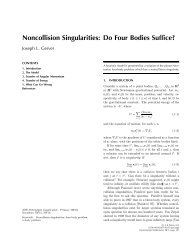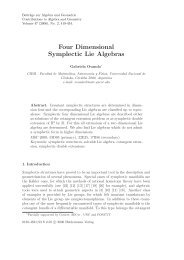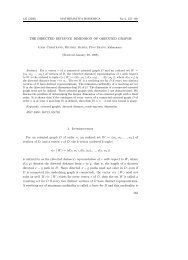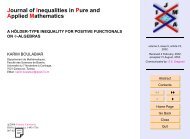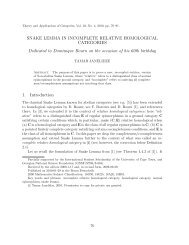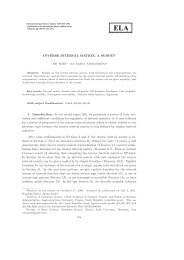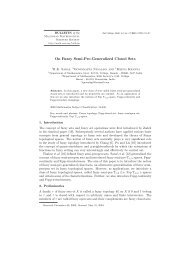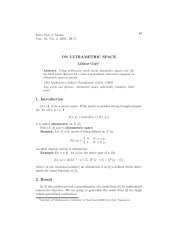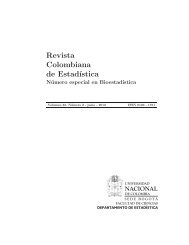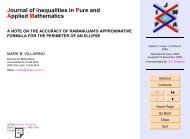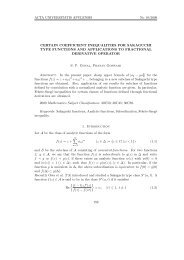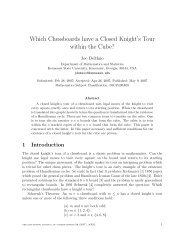Mean transit time and mean residence time for linear diffusion ...
Mean transit time and mean residence time for linear diffusion ...
Mean transit time and mean residence time for linear diffusion ...
You also want an ePaper? Increase the reach of your titles
YUMPU automatically turns print PDFs into web optimized ePapers that Google loves.
Computational <strong>and</strong> Mathematical Methods in Medicine,Vol. 8, No. 1, March 2007, 37–49<strong>Mean</strong> <strong>transit</strong> <strong>time</strong> <strong>and</strong> <strong>mean</strong> <strong>residence</strong> <strong>time</strong> <strong>for</strong><strong>linear</strong> <strong>diffusion</strong>–convection–reaction transportsystemJACEK WANIEWSKI†‡{*†Institute of Biocybernetics <strong>and</strong> Biomedical Engineering PAS, ul. Trojdena 4, 02-109 Warsaw, Pol<strong>and</strong>‡Division of Baxter Novum K56, Department of Clinical Sciences, Karolinska Institutet, Stockholm, Sweden{Interdisciplinary Centre <strong>for</strong> Mathematical <strong>and</strong> Computation Modelling, Warsaw University, ul. Pawinskiego 5a,Warsaw, Pol<strong>and</strong>(Received 22 May 2006; revised 13 September 2006; in final <strong>for</strong>m 15 February 2007)Characteristic <strong>time</strong>s <strong>for</strong> transport processes in biological systems may be evaluated as <strong>mean</strong><strong>transit</strong> <strong>time</strong>s (MTTs) (<strong>for</strong> <strong>transit</strong> states) or <strong>mean</strong> <strong>residence</strong> <strong>time</strong>s (MRT) (<strong>for</strong> steady states).It is shown in a general framework of a (<strong>linear</strong>) reaction–<strong>diffusion</strong>–convection equation thatthese two <strong>time</strong>s are related. Analytical <strong>for</strong>mulas are also derived to calculate moments of exit<strong>time</strong> distribution using solutions <strong>for</strong> a stationary state of the system.Keywords: <strong>Mean</strong> <strong>transit</strong> <strong>time</strong>; Linear <strong>diffusion</strong>; Transit states; Steady states; Exit <strong>time</strong>distribution function; Higher moments1. IntroductionTransport processes in various structures are investigated by the injection of a bolus amountof a marker at the inlet to the system <strong>and</strong> the measurement of the injected marker fraction atthe outlet from the system as a function of <strong>time</strong>. For example, physiological experiments arecarried out <strong>for</strong> the whole isolated organs, in which exchange of water <strong>and</strong> solutes betweenblood <strong>and</strong> the tissue involves a complex network of membranes <strong>and</strong> distributed transportbarriers [1–3]. Another system of this kind is applied <strong>for</strong> the penetration of infrared photonsinto biological tissues [4–6].<strong>Mean</strong> <strong>transit</strong> <strong>time</strong> (MTT) is usually defined <strong>for</strong> experiments with a momentary input to thesystem of a known amount of substance, M 0 (often a small amount of a labelled <strong>for</strong>m of theinvestigated substance), <strong>and</strong> the recording of its concentration, C, at the outlet fromthe system as a function of <strong>time</strong>. MTT may then be calculated as Ð 10 tCðtÞdt=Ð 10CðtÞdt [1].The theoretical evaluation of MTT needs a solution of the model equations <strong>for</strong> the system,which is generally described by ordinary differential equations (compartment systems) orpartial differential equations (distributed systems). The transport may be convective,diffusive or combined. It was shown that <strong>for</strong> pure diffusive or pure convective transport insome simple transport systems this definition of MTT is equivalent to another one that is<strong>for</strong>mulated <strong>for</strong> the steady state of the system [7–9]. In this case, <strong>for</strong> a steady input of thesolute, the system reaches after some <strong>time</strong> a steady state of the concentration distribution <strong>and</strong>* Email: jacekwan@ibib.waw.plComputational <strong>and</strong> Mathematical Methods in MedicineISSN 1748-670X print/ISSN 1748-6718 online q 2007 Taylor & Francishttp://www.t<strong>and</strong>f.co.uk/journalsDOI: 10.1080/17486700701298293
Taking into account that under the stated assumptions: F out (t) ¼ 2dM(t)/dt, M(t) ! 0 <strong>for</strong>t !1, <strong>and</strong> there<strong>for</strong>e Ð 10 F outðtÞdt ¼ M 0 , one gets:hðtÞ ¼2 1 dMð3ÞM 0 dt<strong>and</strong>, using <strong>for</strong>mula (1):Transit <strong>time</strong> <strong>for</strong> transport systems 39t ¼ 1 M 0ð 10MðtÞdt ð4Þwhere it is assumed that tM(t) ! 0ift !1.If the system is in the steady state then the solute concentration, C S , within the system, thesolute mass, M S , in the system, <strong>and</strong> the solute inflow, F Sin , to the system are constant. TheMRT, t res , i.e. the <strong>mean</strong> <strong>time</strong> the particle that enters the system spends in it, is given as [8]:t res ¼ M SF Sinð5ÞThe equality of t <strong>and</strong> t res was initially shown <strong>for</strong> convective transport of a flow indicator<strong>for</strong> measurements of blood flow <strong>and</strong> volume [7]. Next, the Hardt theorem stated that <strong>for</strong> thesystems with pure <strong>diffusion</strong> <strong>and</strong> the inflow <strong>and</strong> outflow only through the boundary, t ¼ t res[8]. It was mentioned by Hardt that this theorem is also valid <strong>for</strong> the systems with thedistributed source/sink of the solute [8]. We show that this result is valid <strong>for</strong> a general <strong>linear</strong><strong>diffusion</strong>–convection—reaction system (described by elliptic differential operator), <strong>and</strong> thathigher moments of the <strong>transit</strong> <strong>time</strong> distribution function may also be calculated using asteady state solution <strong>for</strong> the system.2. Formulation of the modelThe basic equation <strong>for</strong> C(x, t) in a connected bounded region V of n-dimensional Euclidianspace R n , n $ 1; is:›C›twhere L is a <strong>linear</strong> operator defined as¼ LC þ S ð6ÞLC ¼ 2div F 2 ACð7Þ<strong>and</strong>F ¼ 2D grad C þ JCð8Þ<strong>for</strong> D ¼ðD ij ÞðxÞ; J ¼ðJ i ÞðxÞ; A ¼ AðxÞ $ 0; <strong>and</strong> S ¼ SðxÞ $ 0; i; j ¼ 1; ...n <strong>and</strong> symbols inbold describe n-dimensional vectors or n £ n matrices. Furthermore, it is assumed thatdiffusivity matrix is symmetric, D ij ¼ D ji , <strong>and</strong> that j·D(x)j $ uj·j <strong>for</strong> some u . 0, almost allx [ V, <strong>and</strong> all j [ R n , where R n is n-dimensional Euclidean space, <strong>and</strong> R ¼ R 1 is the set ofreal numbers. The last condition states that L is an elliptic operator, <strong>and</strong> guarantees that<strong>diffusion</strong> goes along the concentration gradient [18].
To proof <strong>for</strong>mula (12) let us defineTransit <strong>time</strong> <strong>for</strong> transport systems 41ð t ð ›CAðx; tÞ ¼ Gðx; y; t 2 uÞs V›u 2 L yC ðy; uÞþ ›G ›u þ L* y G ðx; y; t 2 uÞCðy; uÞdyduð13ÞBecausethen, using equation (6),›G›Gðx; y; t 2 uÞ ¼2›u ›t ðx; y; t 2 uÞ ¼2L* yGðx; y; t 2 uÞð t ðAðx; tÞ ¼ Gðx; y; t 2 uÞSðyÞdydu:sVð14ÞOn the other h<strong>and</strong>, equation (13) may be rearranged as follows:ðAðx; tÞ ¼Cðx; tÞ 2Vð t ðGðx; y; t 2 sÞCðy; sÞdy þ Gðx; y; t 2 uÞF n ðy; uÞdydus ›Vð t ðþ ðDðyÞgrad Gðx; y; t 2 uÞÞ n Cðy; uÞdydus ›Vð15Þusing the Gauss–Ostrogradzki theorem Ð V div B dy ¼ Ð ›V B ndy, <strong>and</strong> the identity div(AB) ¼A div B þ B·grad A <strong>for</strong> scalar function A(y) <strong>and</strong> vector function B(y). The application of theboundary conditions <strong>for</strong> C to the integrals over ›V in equation (15) <strong>and</strong> the comparison ofequations (14) <strong>and</strong> (15) yield <strong>for</strong>mula (12).3. <strong>Mean</strong> <strong>transit</strong> <strong>time</strong>s <strong>for</strong> impulse inputsWe assume that the system has a (stable) steady state C 1 (x) with total massM 1 ¼ Ð V C 1ðxÞdx, <strong>and</strong> this state is disturbed at t ¼ 0 by a pulse function concentrated atx ¼ z : M 0 dðx 2 zÞdðtÞ. Let C(x,t;z) be the solution of equation (6) with the initial conditionC 0 (x;z) ¼ C 1 (x) þ M 0 d(x 2 z), <strong>and</strong> denote Mðz; tÞ ¼ Ð VCðx; t; zÞdx. The MTT is defined as(c.f. equation (4))tðzÞ ¼2 1 ð 1tdmðz; tÞM 0 0ð16Þwhere m(z,t) ¼ M(z,t) 2 M 1 .Integrating by parts one getstðzÞ ¼ 1 ð 12ðtmðz; tÞÞj 1 0M þ mðz; tÞdt0 0ð17Þ
42J. Waniewski<strong>and</strong>, assuming that tm(z, t) ! 0 <strong>for</strong> t !1<strong>and</strong> z [ Vn{›V W > ›V D };tðzÞ ¼ 1 ð 1mðz; tÞdt ¼ 1 ð 1 ððCðx; t; zÞ 2 C 1 ðxÞÞdtdx:M 0 0 M 0 0 VThe solution C(x,t;z) may be found using <strong>for</strong>mula (12) <strong>for</strong> the initial state C 0 (x;z)ðCðx; t; zÞ ¼M 0 Gðx; z; tÞþð t ð2sVð t ðGðx; y; t 2 sÞC 1 ðyÞdy þ Gðx; y; t 2 uÞSðyÞdydus VðDðyÞgrad Gðx; y; t 2 uÞÞ n wðyÞdydu›V Dð t ð2 Gðx; y; t 2 uÞcðyÞdydus ›V Nð18Þð19Þ<strong>for</strong> any s [ [0,t ].Note, that <strong>for</strong>mula (12) applied <strong>for</strong> the steady state C 1 (x) implies that the terms withintegrals in equation (19) sum up to C 1 (x). Thus<strong>and</strong>From equation (9):Cðx; t; zÞ ¼M 0 Gðx; z; tÞþC 1 ðxÞðmðz; tÞ ¼M 0 Gðx; z; tÞdxVð20Þð21Þ›m›t ðz; tÞ ¼ L* z m ðz; tÞ ð22Þwith(1) “no diffusive flux” Neumann boundary condition on ›V W < ›V N :(D grad m) n (z,t) ¼ 0<strong>for</strong> z [ ›V W < ›V N ; t . 0,(2) Dirichlet boundary condition <strong>for</strong> ›V D :m(z,t) ¼ 0 <strong>for</strong> z [ ›V D ; t . 0,(3) Initial condition <strong>for</strong> m:m(z,0) ¼ M 0 <strong>for</strong> z in Vn›V.From equations (18) <strong>and</strong> (20) it follows thatðtðzÞ ¼ Gðx; z; tÞdtdxð 10Now, we may <strong>for</strong>mulate an ordinary differential equation <strong>for</strong> t(z). Let us considerð 1 ðð 1 ðL * z tðzÞ ¼ L * z G ›Gðx; z; tÞdtdx ¼ ðx; z; tÞdtdx0 V0 V ›tð¼ ½Gðx; z; 1Þ 2 Gðx; z; 0ÞŠdxVVð23Þð24Þ
Transit <strong>time</strong> <strong>for</strong> transport systems 43Note, that G(x,z,t) ! 0 <strong>for</strong> t !1, because of the boundary conditions <strong>for</strong> G, <strong>and</strong> thatG(x,z,0) ¼ d(x 2 z). There<strong>for</strong>eL * z t ðzÞ ¼21ð25ÞThis PDE is supplemented by the boundary conditions that are of the same type as <strong>for</strong>G(x,z,t):(1) (›t/›n)(z) ¼ 0 <strong>for</strong> z [ ›V W < ›V N ;(2) t(z) ¼ 0 <strong>for</strong> z [ ›V D .Remark. Defining tðz; tÞ ¼ Ð t Ð0 VGðx; z; uÞdudx one can derive an equation <strong>for</strong> t(z,t):4. <strong>Mean</strong> <strong>residence</strong> <strong>time</strong>›t›t ðz; tÞ ¼ L* z t ðz; tÞþ1: ð26ÞLet CðxÞ be a steady state solution <strong>for</strong> equation (6) <strong>for</strong> some boundary conditions, perhapsdifferent from those already specified, which will be defined later on. Then, by equation (25),ðCðzÞ L * z t ðzÞdz ¼ 2 Mð27ÞVwhereðM ¼VCðzÞdzð28ÞOn the other h<strong>and</strong>,ððCðzÞ L * z t ðzÞdz ¼VVL zC ððzÞtðzÞdz þ›VCðD grad tÞ n þ t F nðzÞdzð29ÞBecause L zC ðzÞ ¼2SðzÞ by the definition of the stationary state, one gets, comparingequations (27) <strong>and</strong> (29) <strong>and</strong> using the boundary conditions <strong>for</strong> t,ððM ¼ 2 ð CðD grad tÞ n ÞðzÞdz 2 t F n ðzÞdz þ SðzÞtðzÞdz ð30Þ›V Dð›V N VLet us assume now the boundary conditions <strong>for</strong> C, c.f. [8],(1) F n ðzÞ ¼0 <strong>for</strong> z [ ›V W ,(2) F n ðzÞ ¼2 cðzÞ, cðzÞ $ 0 <strong>for</strong> z [ ›V N , with ›V N considered as the inlet to the system,(3) CðzÞ ¼ wðzÞ, wðzÞ $ 0 <strong>for</strong> z [ ›V D ,with›V D considered as the outlet from the system.The total inflow through the boundary, F inlet , is thenðF inlet ¼ cðzÞdz ð31Þ›V N
44J. WaniewskiThe inflow-averaged <strong>mean</strong> <strong>time</strong> t inlet <strong>for</strong> the solute entering the system through ›V N isdefined ast inlet ¼ 1 ððt cÞðzÞdz ð32ÞF inlet ›V NThe total inflow from the source is F source ¼ Ð VSðzÞdz, <strong>and</strong> the inflow-averaged <strong>mean</strong> <strong>time</strong>t source <strong>for</strong> the solute entering the system from the source is defined ast source ¼ 1 ðtSÞðzÞdzF sourceðVEquations (30)–(33) together with the boundary conditions <strong>for</strong> C yield the <strong>for</strong>mulaðt inflow 2 ð wðD grad tÞ n ÞðzÞdz ¼›V DMF inlet þ F sourceð33Þð34Þwhere M <strong>and</strong> F inlet are calculated <strong>for</strong> the steady state C, <strong>and</strong> t inflow is defined ast inflow ¼F inletF sourcet inlet þt source :F inlet þ F sourceF inlet þ F sourceð35ÞNote that the <strong>residence</strong> <strong>time</strong>, t res , <strong>for</strong> this system is defined ast res ¼MF inlet þ F sourceð36Þc.f. equation (5). Thus, <strong>for</strong> w ; 0 one gets from equation (34) thatt inflow ¼ t resð37Þi.e. the Hardt theorem [8]. Formula (34) may be there<strong>for</strong>e considered as a generalization ofthe Hardt theorem to arbitrary Dirichlet conditions at the outlet from the system.The inflow-averaged <strong>mean</strong> <strong>time</strong> t inflow <strong>for</strong> the solute entering the system through ›V Ndepends on the boundary condition cðzÞ at the inlet. However, if cðzÞ does not depend onz [ ›V N , thent inflow ¼ 1 ðtðzÞdz ð38Þj›V N j ›V Nt inflow , given by equation (38), may be calculated directly if equation (25) is solved.5. Higher moments of exit functionUsing similar methods we can derive recursive equations <strong>and</strong> <strong>for</strong>mulas <strong>for</strong> higher momentsof the exit <strong>time</strong> distribution function defined ast k ðzÞ ¼2 1 ð 1t k dmðt; zÞM 0 0ð39Þ
Transit <strong>time</strong> <strong>for</strong> transport systems 45<strong>for</strong> integer k $ 0. Note that t 0 (z) ¼ 1. In the following, we assume that t k mðt; zÞ ! 0 <strong>and</strong>t k21 Gðx; z; tÞ ! 0 <strong>for</strong> t !1, z [ Vn{›V W > ›V D }, <strong>and</strong> all integer k $ 1. Then, <strong>for</strong> k $ 1t k ðzÞ ¼ k ð 1 ð 1 ðt k21 mðt; zÞdt ¼ k t k21 Gðx; z; tÞdtdxð40ÞM 0 00c.f. equations (17) <strong>and</strong> (23) <strong>and</strong> their derivations. The PDE <strong>for</strong> t k (z) is obtained in the sameway as equation (25):VL * z t kðzÞ ¼2ktk21 ðzÞ ð41Þ<strong>and</strong> the boundary conditions are the same as those <strong>for</strong> equation (25).The theorem by Hardt about the description of MTT by MRT [8], section 4, may begeneralized <strong>for</strong> higher moments of exit functions. Let us define the following parameters:t k;source ¼ 1 ðt k SÞðzÞdzF sourceðVð42Þt k;inlet ¼ 1F inletð›V Nðt kcÞðzÞdz ð43Þ<strong>for</strong> the steady state C. Thent k ¼ 1 MðVð Ct k ÞðzÞdzðt k;inflow 2 ð wðD grad t k Þ n ÞðzÞ ¼›V Dk M t k21F inlet þ F sourceð44Þð45Þwhere M <strong>and</strong> F inlet are calculated <strong>for</strong> the steady state C, <strong>and</strong> t k,inflow is defined ast k;inflow ¼F inletF sourcet k;inlet þt k;sourceF inlet þ F sourceF inlet þ F sourceð46ÞFor k ¼ 1, <strong>for</strong>mulae (42)–(46) reduce to those given in section 4.6. ExamplesLet us consider the transport equation with constant coefficients on interval ½0; LŠ›C›T ¼ D ›2 C›X 2 2 J ›C›XAfter rescaling with x ¼ X/L <strong>and</strong> t ¼ DT=L 2 we get›C›t ¼ ›2 C›x 2 2 j ›C›x2 AC þ S ð47Þ2 aC þ s ð48Þ
46J. Waniewskiwith the coefficients j ¼ JL=D, a ¼ AL 2 =D, s ¼ SL 2 =D. Equation (25) is now› 2 t›z 2 þ j ›t 2 at ¼ 21 ð49Þ›zwith (›t/›z)(0) ¼ 0 <strong>and</strong> t(1) ¼ 0. The solution of equation (49) <strong>for</strong> j, a – 0istðzÞ ¼ 1 u coshðuz=2Þþj sinhðuz=2Þ1 2 expðjð1 2 zÞ=2Þau coshðu=2Þþj sinhðu=2Þpwhere u ¼ffiffiffiffiffiffiffiffiffiffiffiffiffiffiffij 2 þ 4a.Important special cases of solution (50) areð50Þ(1) <strong>for</strong> j – 0, a ¼ 0(2) <strong>for</strong> j ¼ 0, a . 0(3) <strong>for</strong> j ¼ 0, a ¼ 0tðzÞ ¼ 1 j1 2 z 2 expð2jÞðexpðjð1 2 zÞÞ 2 1ÞjtðzÞ ¼ 1 a1 2 coshð pffiffia zÞpffifficoshð a ÞtðzÞ ¼ 1 2 ð1 2 z 2 Þð51Þð52Þð53Þ<strong>and</strong>, <strong>for</strong>t 2 ðzÞ ¼ 1 52 6 2 z 2 1 2 z 2 6ð54ÞvarðzÞ ¼2 1 ð 1ðt 2 tÞ 2 dmðt; zÞ ¼t 2 2 t 2 ;M 0 0varðzÞ ¼ 1 6 ð1 2 z 4 Þ:ð55ÞFor the Dirichlet boundary conditions at both boundaries <strong>for</strong> the main equation (49) onehas the boundary conditions <strong>for</strong> t:t(0) ¼ 0 <strong>and</strong> t(1) ¼ 0. Then, the solution of equation (49)<strong>for</strong> j, a – 0ispwhere u ¼ffiffiffiffiffiffiffiffiffiffiffiffiffiffiffij 2 þ 4a.tðzÞ ¼ 1 a1 2 eðu2jÞz=2 þðe u=2 2 e j=2 2jz=2 sinhðuz=2ÞÞesinhðu=2Þð56Þ
Some special cases of solution (56) are:Transit <strong>time</strong> <strong>for</strong> transport systems 47(1) <strong>for</strong> j – 0, a ¼ 0tðzÞ ¼ 1 j1 2 expð2jzÞ1 2 expð2jÞ 2 zð57Þ(2) <strong>for</strong> j ¼ 0, a . 0tðzÞ ¼ 1 pffiffiffia1 2 expð pffiffipffiffisinhð a zÞa zÞþðexpð a Þ 2 1Þ pffiffiffisinhð a Þð58Þ(3) <strong>for</strong> j ¼ 0, a ¼ 0tðzÞ ¼ 1 zð1 2 zÞ:2 ð59ÞFor the Neumann boundary conditions at both boundaries <strong>for</strong> the main equation (49) onehas the boundary conditions <strong>for</strong> t :(dt/dz)(0) ¼ 0 <strong>and</strong> (dt/dz)(1) ¼ 0. Then, the solution ofequation (49) <strong>for</strong> a – 0ist ðzÞ ¼ 1 að60ÞHowever, there is no solution if a ¼ 0.7. DiscussionThe equivalence of the passage <strong>time</strong>s <strong>for</strong> transient <strong>and</strong> steady <strong>linear</strong> transport processes isshown <strong>for</strong> the general <strong>linear</strong> reaction–<strong>diffusion</strong>–convection equation in R n , n . 1. It wasdescribed previously as the identity of MTT <strong>and</strong> MRT <strong>for</strong> pure convective <strong>and</strong> pure diffusivetransport separately [7,8]. This identity is now proved <strong>for</strong> combined diffusive–convectivetransport with a possible <strong>linear</strong> chemical reaction. However, the “reaction” term may alsodescribe an internal sink of the solute, extending considerably (e.g. due to the presence ofblood microvessels <strong>and</strong> lymphatics) the range of systems under consideration. Furthermore,<strong>for</strong>mula (46) demonstrates how higher moments of the distribution of passage <strong>time</strong>s may becalculated from a steady state solution of the transport equation. The presented proof is basedon the theory of <strong>linear</strong> parabolic differential equations, but physical arguments may refer tothe assumption that the motion of any single molecule is independent of the motion of allother particles, as reflected by the <strong>linear</strong>ity of the system. There<strong>for</strong>e, the proof might be alsobased on the theory of stochastic processes, as it was used in Ref. [8].Although the transport-reaction systems are in general non-<strong>linear</strong>, the <strong>linear</strong> equations aresome<strong>time</strong>s applicable <strong>for</strong> some of these systems. There may be several reasons <strong>for</strong> usefulnessof <strong>linear</strong> systems in biological applications. First of all, some solutes are chemically “inert” <strong>and</strong>transported only by passive <strong>diffusion</strong> <strong>and</strong> convection, as <strong>for</strong> example, urea <strong>and</strong> creatinine, thebasic markers <strong>for</strong> the clinical status of uremic patients <strong>and</strong> the efficiency of dialysis procedures,inert gases <strong>and</strong> some drugs, etc. [1,3,12,14–16]. Also, <strong>linear</strong> approximations <strong>for</strong> some generalmodels are found to be accurate <strong>and</strong> practically useful descriptions, as in near-infrared
48J. Waniewskispectroscopy [4–6]. Linearized systems appear also if small quantities of labelled markers areapplied in experiments, because such small quantities do not change the state of the system [1].Finally, <strong>linear</strong> systems are studied just as an approximation to obtain an initial insight into thesystem characteristics [11,14]. The parameters estimated from the experimental data <strong>for</strong> <strong>linear</strong>systems may later be used directly or by interpolation <strong>for</strong> solutes that are involved in, say, <strong>linear</strong>transport <strong>and</strong> non-<strong>linear</strong> reaction, etc. Note also that <strong>transit</strong> <strong>and</strong> <strong>residence</strong> <strong>time</strong>s may be definedin a dose/concentration independent manner only <strong>for</strong> <strong>linear</strong> systems.The theorem about the equality of MRT <strong>and</strong> MTT depends on the assumption that afterperturbation of the system the total solute mass in the system returns to its steady state levelasymptotically faster than t 21 , see equations (4) <strong>and</strong> (17)–(18). Furthermore, the derived<strong>for</strong>mulas <strong>for</strong> higher moments of the exit function are based on the assumption that theasymptotic rate of return of the system mass to its steady state value is faster than t 2k if the kmoment is considered (see section 5). These properties of the exit function, taken <strong>for</strong> grantedin previous studies [7,8], are difficult to prove <strong>for</strong> general elliptic operators. The problemmay be reduced to the investigation of the principal (maximal) eigenvalue of the ellipticoperator that describes the system. Operator L, Equation (7), is in general the non-symmetricif convective term J – 0. Nevertheless, it may often be shown that its principal eigenvalue isreal <strong>and</strong> strictly negative <strong>and</strong> all other eigenvalues have real parts not higher than theprincipal eigenvalue if A . 0, see a proof <strong>for</strong> the case of Dirichlet boundary condition in Ref.[18]. From such a characteristic of the operator’s spectrum a conclusion about the desiredasymptotic properties of the solute mass may easily be obtained.The observation that in<strong>for</strong>mation about the exit function <strong>for</strong> the <strong>linear</strong> transport systemsmay be derived at large extent from a steady state solution may be helpful in obtaininganalytical <strong>for</strong>mulas <strong>for</strong> systems with simple geometry, as shown in section 6 <strong>and</strong> Ref. [8]. Itmay potentially be useful <strong>for</strong> numerical analysis of the transport systems. It also allows <strong>for</strong>the derivation of some conclusions about <strong>transit</strong> characteristics from the studies of the systemin the steady state.References[1] Bassingthwaighte, J.B. <strong>and</strong> Goresky, C.A., 1984, Modeling in the analysis of solute <strong>and</strong> water exchange in themicrovasculature. In: S.R. Geiger, C.C. Michel, J.R. Pappenheimer <strong>and</strong> E.M. Renkin (Eds.) H<strong>and</strong>book ofPhysiology—The Cardiovascular System IV, Vol. 4 (Microcirculation. Bethesda, MD: American PhysiologicalSociety).[2] Beard, D.A. <strong>and</strong> Bassingthwaighte, J.B., 2000, Advection <strong>and</strong> <strong>diffusion</strong> of substances in biological tissues withcomplex vascular networks, Annals of Biomedical Engineering, 28(3), 253–268.[3] Roberts, M.S. <strong>and</strong> Anissimov, Y.G., 1999, Modeling of hepatic elimination <strong>and</strong> organ distribution kinetics withthe extended convection–dispersion model, Journal of Pharmacokinetics <strong>and</strong> Biopharmaceutics, 27(4),343–382.[4] Arridge, S.R. <strong>and</strong> Schweiger, M., 1995, Direct calculation of the moments of the distribution of photon <strong>time</strong> offlight in the tissue with finite element method, Applied Optics, 34(15), 2683–2687.[5] Liebert, A., Wabnitz, H., Grosenick, D., Moller, M., Macdonald, R. <strong>and</strong> Rinneberg, H., 2003, Evaluation ofoptical properties of highly scattering media by moments of distributions of <strong>time</strong>s of flight of photons, AppliedOptics, 42(28), 5785–5792.[6] Liebert, A., Wabnitz, H., Steinbrink, J., Obrig, H., Moller, M., Macdonald, R., et al., 2004, Time-resolvedmultidistance near-infrared spectroscopy of the adult head: intracerebal <strong>and</strong> extracerebal absorption changesfrom moments of distribution of flight of photons, Applied Optics, 43(15), 3037–3047.[7] Meier, P. <strong>and</strong> Zierler, K., 1954, On the theory of the indicator-dilution method <strong>for</strong> measurement of blood flow<strong>and</strong> volume, Journal of Applied Physiology, 12(6), 731–744.[8] Hardt, S.L., 1981, The <strong>diffusion</strong> <strong>transit</strong> <strong>time</strong>; a simple derivation, Bulletin of Mathematical Biology, 45, 89–99.[9] Segel, L.A., 1980, Mathematical Models in Molecular <strong>and</strong> Cellular Biology (Cambridge: CambridgeUniversity Press).
Transit <strong>time</strong> <strong>for</strong> transport systems 49[10] Mellick, G.D., Anissimov, Y.G., Bracken, A.J. <strong>and</strong> Roberts, M.S., 1997, Metabolite <strong>mean</strong> <strong>transit</strong> <strong>time</strong>s in theliver as predicted by various models of hepatic elimination, Journal of Pharmacokinetics <strong>and</strong>Biopharmaceutics, 25(4), 477–505.[11] Roberts, M.S. <strong>and</strong> Rowl<strong>and</strong>, M., 1986, A dispersion model of hepatic elimination: 1. Formulation of the model<strong>and</strong> bolus considerations, Journal of Pharmacokinetics <strong>and</strong> Biopharmaceutics, 14(3), 227–260.[12] Flessner, M.F., 2005, The transport barrier in intraperitoneal therapy, American Journal of Physiology RenalPhysiology, 288(3), F433–F442.[13] Flessner, M.F., 2001, Transport of protein in the abdominal wall during intraperitoneal therapy. I. Theoreticalapproach, American Journal of Physiology. Gastrointestinal <strong>and</strong> Liver Physiology, 281(2), G424–G437.[14] Waniewski, J., 2001, Physiological interpretation of solute transport parameters <strong>for</strong> peritoneal dialysis, Journalof Theoretical Medicine, 3, 177–190.[15] Waniewski, J., Werynski, A. <strong>and</strong> Lindholm, B., 1999, Effect of blood perfusion on diffusive transport inperitoneal dialysis, Kidney International, 56(2), 707–713.[16] Waniewski, J., 2002, Distributed modeling of diffusive solute transport in peritoneal dialysis, Annals ofBiomedical Engineering, 30(9), 1181–1195.[17] Waniewski, J., 2004, A mathematical model of local stimulation of perfusion by vasoactive agent diffusingfrom tissue surface, Cardiovascular Engineering An International Journal, 4(1), 115–123.[18] Evans, L.C., 1998, Partial Differential Equations (Providence, RI: American Mathematical Society).



